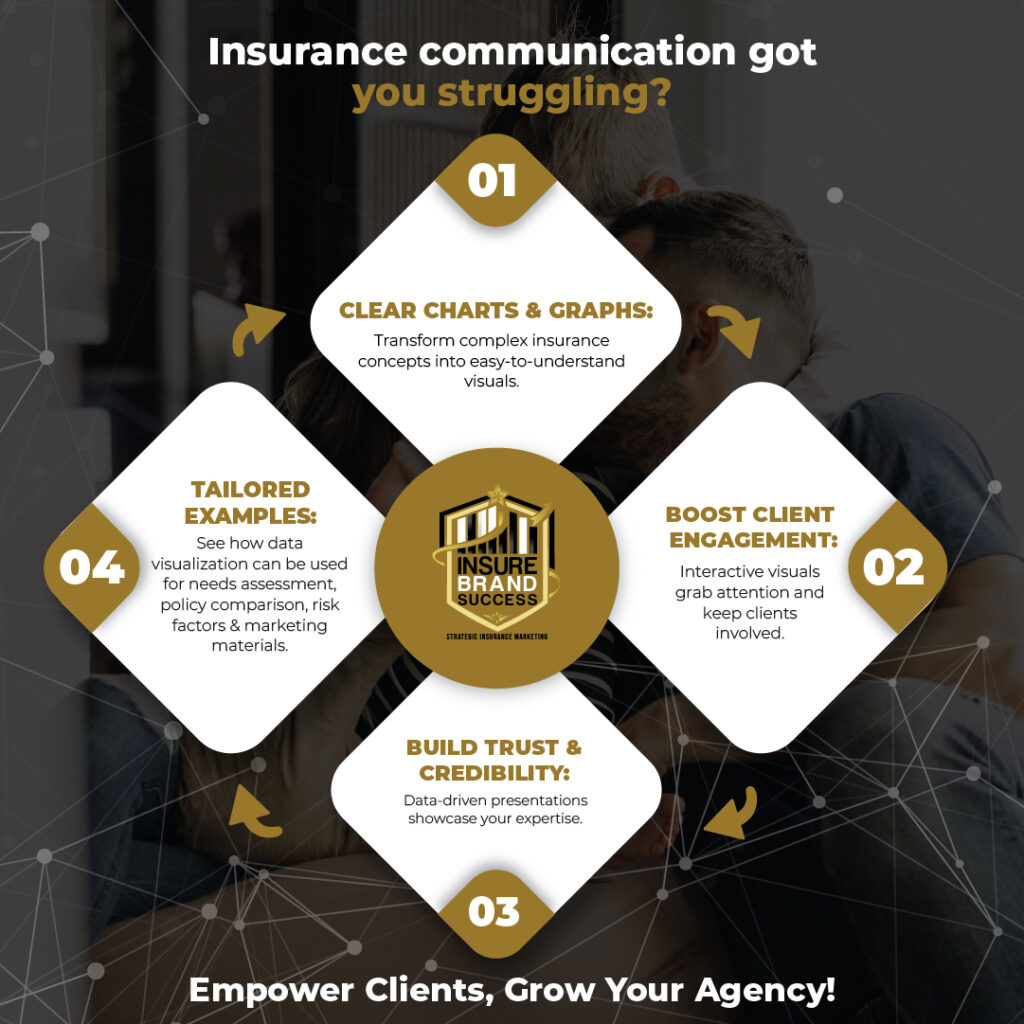In the world of insurance, clear communication is everything. Whether you’re explaining complex policy details, outlining coverage options, or highlighting the benefits of a particular product, how well you convey your message can make or break a client’s decision to choose your agency. Insurance can often feel like an overwhelming topic for many clients due to the sheer amount of numbers, jargon, and legal terminology. For this reason, many insurance agents struggle to simplify complex ideas without losing essential details.
Enter data visualization. By translating complex information into clear and concise charts and graphs, insurance professionals can transform their communication into something visually engaging, easy to understand, and impactful. Charts and graphs can help you break down data, simplify comparisons, and ensure your clients grasp the full picture, making your agency stand out in an increasingly competitive landscape.
Why Data Visualization Matters for Insurance Agents
We live in a world where people are constantly bombarded with information. In fact, studies show that humans process visuals 60,000 times faster than text. With so much data competing for attention, well-designed charts and graphs can capture a client’s interest immediately, making it easier to communicate even the most complex insurance details.
Here’s why data visualization is a game-changer for insurance agents:
1. Increased Client Understanding
Insurance can be daunting to understand for many clients. However, when you present policy options, coverage details, or premium breakdowns in the form of pie charts, bar graphs, or line charts, you help clients see the data in a way that makes sense. For instance, using a pie chart to explain how a client’s premiums are allocated can quickly clarify what percentage goes toward specific coverage areas like liability or property damage.
2. Improved Communication and Engagement
Visuals naturally invite conversation. A well-designed chart can lead clients to ask more informed questions, sparking deeper discussions about their needs and options. This kind of engagement is vital to building a client’s trust. Furthermore, clients are more likely to stay engaged with information they can see and interact with, rather than pages of complicated text.
3. Enhanced Credibility and Authority
Using data-backed visuals demonstrates that you’re not only knowledgeable but also prepared to provide evidence for your recommendations. By presenting data clearly, you build credibility with your clients, solidifying yourself as an authority in the insurance field. This is especially critical when explaining risk factors or policy comparisons, where clients depend on accurate and clear information to make well-informed decisions.
4. Boosted Marketing Efforts
In addition to helping with client communication, data visualization can elevate your marketing efforts. Infographics, social media visuals, and interactive charts can catch the eye of potential clients and encourage them to learn more about your services. A well-designed infographic on the benefits of umbrella insurance, for example, can be shared on platforms like Facebook or LinkedIn, helping to expand your reach.
To fully integrate these tools, consider working with professionals to optimize your approach. For instance, Insurance SEO Services can help enhance your digital presence by optimizing content that uses data visualization for SEO.
Turning Data into Visual Gems: Essential Tips for Insurance Agents
Now that we’ve covered the importance of data visualization, let’s explore some practical tips to help you incorporate it into your insurance communication:
1. Know Your Audience
Before you create any chart or graph, you need to understand your audience’s level of familiarity with the data. If your clients are mostly first-time homebuyers, for example, you’ll want to use simple visualizations, like pie charts, to explain basic concepts like how their premiums are divided between different types of coverage. For a more experienced audience, such as business owners seeking commercial insurance, you can delve into more detailed comparisons using bar graphs or scatter plots.
2. Choose the Right Chart Type
Each type of chart has its specific strength. For example:
- Pie Charts: Perfect for showing proportions, like how much of a premium is allocated to different coverages.
- Bar Charts: Great for comparing different policy options, such as deductible amounts or premium costs across plans.
- Line Graphs: Ideal for showing trends over time, like how a client’s premium has fluctuated based on claims or risk factors.
Be intentional with your choice of chart to ensure it supports the message you want to convey.
3. Focus on Clarity and Conciseness
Don’t overwhelm your clients with cluttered visuals. Use simple labels, clear legends, and a limited color palette to ensure that your charts are easy to read. If necessary, break large datasets into multiple visuals rather than cramming everything into one chart.
4. Highlight Key Points
Data visualization should emphasize key takeaways. Use bold colors, larger text, or icons to call attention to important details like risk factors, coverage gaps, or policy benefits. Highlighting essential data ensures that your clients don’t miss the most crucial points of your message.
5. Tell a Story with Your Data
Clients will retain information better if they understand why it matters. Don’t just present data—tell a story with it. For example, use a line graph to show how age affects life insurance premiums and follow it up by explaining how clients can lock in lower premiums by purchasing insurance earlier. Contextualizing data helps clients understand its impact and encourages them to take action.
Examples of Data Visualization for Insurance Agents
Let’s look at some practical ways you can leverage data visualization in your communication with clients:
1. Client Needs Assessment
During client assessments, you might find gaps in coverage, such as homeowners lacking flood insurance in a high-risk area. A pie chart can visually represent how many of your clients are missing this critical coverage.
Pro Tip: Add a brief call to action within the chart:
“35% of homeowners in flood-prone areas lack adequate flood insurance. Is your home protected?”
2. Policy Comparison
Clients often need help understanding the differences between policy options. Use a bar chart to compare deductibles and coverage limits across different plans (e.g., Bronze, Silver, Gold).
Pro Tip: Use icons to represent the ideal user for each tier, such as a house icon for homeowners or a car for auto insurance.
3. Risk Factors
Explaining how factors like age or driving history affect premiums can be difficult. Use a line graph to illustrate how a clean driving record over time results in lower premiums, compared to a history with claims or accidents.
Pro Tip: Include a note within the chart:
“Drivers with no accidents can save up to 20% on their premiums over five years.”
4. Claims Statistics
If you notice that your clients are frequently filing certain types of claims (e.g., water damage, theft, or liability), create an infographic that highlights the most common claims in your area. This helps clients understand why specific coverages are essential.
Pro Tip: Share this infographic on social media and tie it to a relevant blog post about common claims, such as those optimized by AdWords for Insurance Agencies to attract more potential clients.
5. Client Testimonials with Data
Client testimonials are powerful when paired with supporting data. For example, create a testimonial slide that includes a satisfied customer’s quote alongside data points that illustrate how much money they saved by switching to your agency.

Beyond the Basics: Advanced Data Visualization Techniques
Once you’ve mastered the basics, you can take your data visualization skills to the next level with more advanced techniques:
1. Interactive Data Visualizations
Interactive visuals allow clients to explore the data themselves. For instance, using an interactive premium calculator, clients can input their age, coverage needs, and driving record to see how their premiums change. These tools make the data personal, which can boost client engagement.
Pro Tip: Partner with web design experts like Website Design for Insurance Agencies to create interactive tools that fit seamlessly into your website.
2. Data Storytelling
Take data visualization a step further by developing a narrative around your data. Use a series of visuals that walk clients through the benefits of specific insurance policies, showing how they can save money or reduce risks. This approach not only presents data but also frames it in a way that resonates emotionally with clients.
3. Custom-Designed Infographics
Invest in high-quality, branded infographics that visually represent your agency’s unique value proposition. Infographics can be shared across social media, on your website, or in marketing emails. They provide visually appealing, easy-to-digest information that enhances your digital marketing strategy.
External Resources for Data Visualization Tools
To create professional-looking charts and graphs, consider using these trusted data visualization tools:
- Canva – A user-friendly tool for designing simple charts, infographics, and marketing visuals.
- Google Data Studio – An advanced tool that allows you to create interactive dashboards and visuals from your data.
- Tableau – A powerful data visualization software for building more detailed, interactive graphs and charts.
Conclusion: Data Visualization – A Game-Changer for Insurance Communication
Data visualization can transform your insurance communication, turning complex policy details into simple, engaging visuals that foster deeper client understanding. Whether you’re explaining coverage options, breaking down premiums, or highlighting the risks clients face, charts and graphs are invaluable tools for ensuring clarity and building trust.
Remember, a picture is worth a thousand words, and in the world of insurance, a well-designed chart or graph could be worth a thousand explanations. So, embrace data visualization, make your communication dynamic, and provide your clients with the knowledge and confidence they need to make informed decisions.
For expert assistance in building a comprehensive digital marketing strategy with data visualization at its core, contact EnsureBrandSuccess.com and take your insurance agency to the next level!




